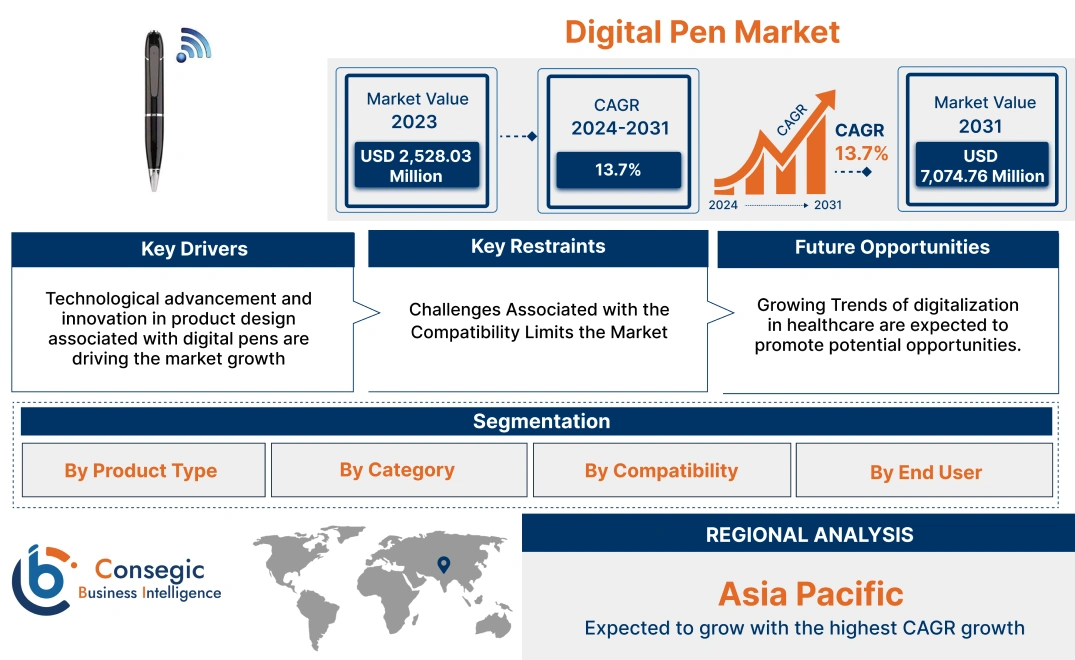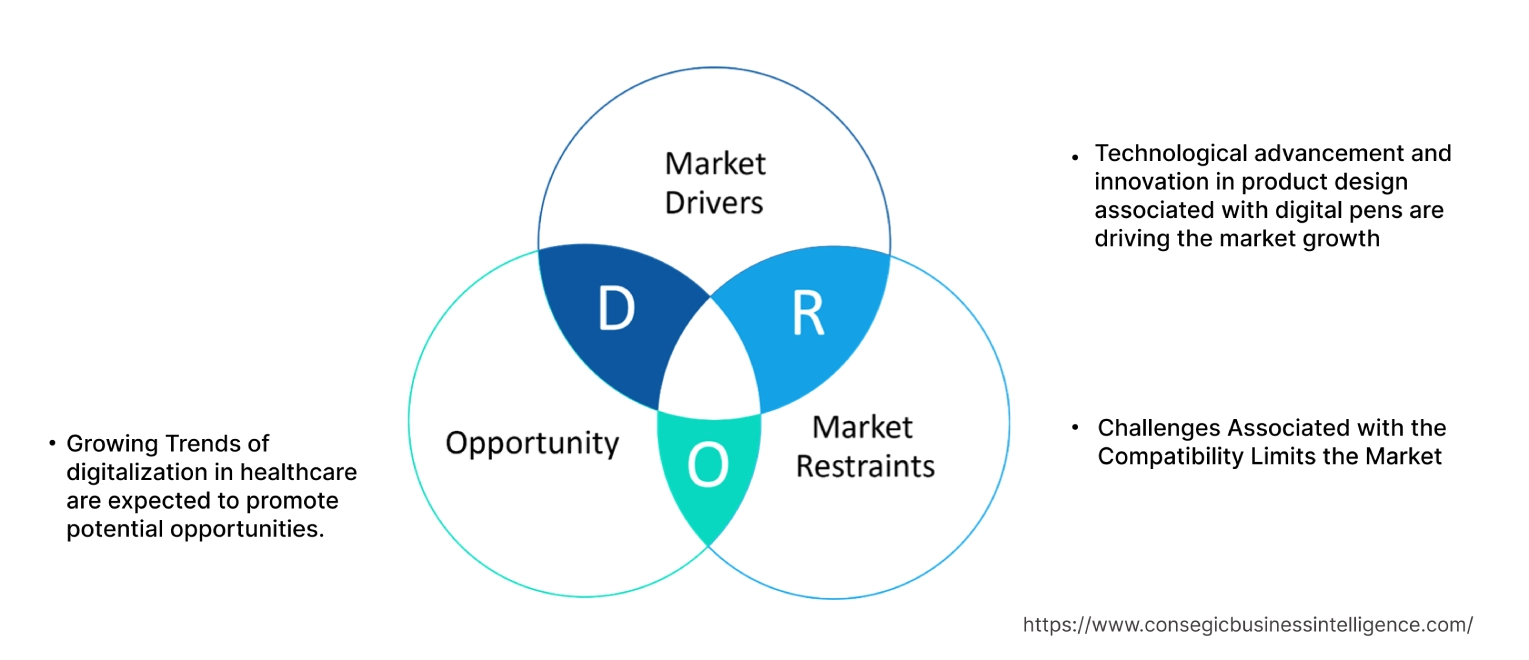Digital Pen Market Size:
Digital Pen Market size is estimated to reach over USD 7,074.76 Million by 2031 from a value of USD 2,528.03 Million in 2023 and is projected to grow by USD 2,830.03 Million in 2024, growing at a CAGR of 13.7% from 2024 to 2031.
Digital Pen Market Scope & Overview:
A digital pen refers to an input device that captures and converts the handwriting or brush strokes of a user into digital data, making it usable in various applications. These pens can be used on devices like tablets and smartphones, or even special paper, to digitize notes, drawings, and more. Some models also offer advanced features like pressure sensitivity, palm rejection, and extended battery life. Moreover, a digital pen offers several benefits such as precision in interacting with the screen, screen protection, enhanced functionality, convenience and efficiency, pressure sensitivity, cognitive development, workflow engagement, and others. The above benefits are primary determinants for increasing their deployment in BFSI, healthcare, government, media & entertainment, education, retail, and other industries.
How is AI Impacting the Digital Pen Market?
AI is transforming the digital pen market by infusing devices with intelligence far beyond simple handwriting capture. AI-powered algorithms enable highly accurate handwriting and sketch recognition, converting analog notes into editable digital text in real-time. The technology is also facilitating features like real-time translation, personalized learning recommendations, and automatic note organization. By analyzing writing patterns, AI can even offer insights into user behavior and assist in the early detection of cognitive and motor skills issues. This integration of smart features is elevating digital pens from basic tools to sophisticated productivity and accessibility devices, driving innovation and market growth.
Digital Pen Market Insights:
Digital Pen Market Dynamics - (DRO) :
Key Drivers:
Technological advancement and innovation in product design associated with digital pens are driving the market growth
Innovation in technology and product design leads to the development of new and improved products that meet the changing needs and preferences of consumers. This, in turn, can attract more customers, increase market share, and boost sales. Furthermore, technological innovation can also lead to improved efficiency and productivity, reducing costs and increasing profitability. Digital Pen offers pressure sensitivity, wireless connectivity, and rechargeable battery, compatibility with devices, easy storage and organization, and others. As a result, the rising innovation in technology and products is driving the market.
- For instance, in March 2020, reMarkable 2 was released with exceptional features including a thin design, an E-ink display with unprecedented responsiveness, extended battery life, and smarter accessories.
Therefore, the rising innovation in technology and product design is increasing the adoption of digital pens, which in turn is proliferating the digital pen market growth.
Key Restraints :
Challenges Associated with the Compatibility Limits the Market
Digital pens often need to be seamlessly integrated with different hardware, such as tablets, laptops, and smartphones, as well as software applications used in design, note-taking, and document editing. However, compatibility issues arise due to the diversity of devices and operating systems, such as iOS, Android, and Windows, each requiring specific drivers or software configurations to function optimally.
Additionally, the lack of standardized protocols across manufacturers further complicates compatibility. For instance, a digital pen optimized for one device or brand may have limited functionality or fail to work altogether with another brand's products. This lack of interoperability limits the appeal of digital pens to consumers and businesses, as users seek devices that can easily transition across different platforms without technical barriers.
- For instance, in March 2022, the USI 2.0 standard introduced significant advancements such as wireless charging for styluses and improved tilt and shading features. However, it also introduced a compatibility issue. Devices supporting USI 2.0, such as the Lenovo Chromebook Duet 3, may not work with older USI 1.0 styluses due to the in-cell design of the display, which integrates the display and digitizer for stylus input. Despite efforts to ensure backward compatibility, it was not achievable due to the tight integration of the touch and display driver in the in-cell design.
Therefore, these compatibility challenges restrict the adoption of digital pens across a broad range of use cases and industries, slowing market growth as consumers and enterprises hesitate to invest in technology that may not work reliably across their preferred devices and software.
Future Opportunities :
Growing Trends of digitalization in healthcare are expected to promote potential opportunities.
The digital pen market will experience significant growth, driven by the increasing trend of digitalization in the healthcare sector. This is fueled by the need for digitization across various sectors, including healthcare, and the adoption of electronic health records (EHRs) by healthcare professionals. Furthermore, the global digital pen market is driven by the strong domestic market for telehealth care platforms, mHealth apps, wearable devices, and e-prescription systems.
- For instance, according to the Press Information Bureau of India, the Digital India initiative has led to significant digital transformation in India's healthcare sector. Platforms like Ayushman Bharat Digital Mission, CoWIN App, Aarogya Setu, e-Sanjeevani, and e-Hospital have made healthcare services accessible across the country. These platforms facilitate digital health records, telemedicine services, vaccine distribution, and hospital management, among other services, thereby bridging the gap in the healthcare ecosystem.
Hence, the digital pen market stands at the intersection of traditional writing and digital transformation, with growing potential across industries like healthcare that are prioritizing seamless, secure data capture, and creating lucrative digital pen market opportunities.
Digital Pen Market Segmental Analysis :
By Product Type:
Based on the product type, the market is segmented into scanning pen and handwriting pen.
The handwriting pen segment accounted for the largest revenue of the total digital pen market share in the year 2023.
- The handwriting pen refers to a type of digital pen that allows users to write or draw directly on digital surfaces, such as tablets, smartphones, or computers.
- The product's effectiveness is amplified by the integration of various sensors, including IR cameras, pressure sensitivity, positional sensors, and accelerometers. This implementation of the technology enables users to record and transfer text, diagrams, drawings, and quick notes to a computer, enhancing its utility across different applications, and making them advantageous in a variety of sectors such as healthcare, education, banking, and retail.
- For instance, in October 2023 Apple unveiled a new version of its Apple Pencil, which is more cost-effective. The updated Apple Pencil boasts features such as precision, minimal delay, and tilt sensitivity, making it perfect for activities like jotting down notes, creating sketches, making annotations, and keeping a journal. It can be paired and charged using a USB-C cable and is compatible with all iPad models equipped with a USB-C port.
- Thus, the market trends analysis shows that the rising innovation associated with handwriting pen is driving the digital pen market demand.
The scanning pen segment is anticipated to register the fastest CAGR during the forecast period.
- A scanning pen, often known as a pen scanner, is a portable device that comes with an Optical Character Recognition (OCR) sensor.
- It is designed to scan text and individual words from physical documents and convert the scanned text into a digital format for easy editing, storage, and sharing.
- It features text scanning, digital conversion, text-to-speech capabilities, and translation functionality.
- For instance, NEWYES SCAN READER PEN 3 launched in March 2022, is a versatile tool designed for various applications such as study, business, travel, and daily use. It is equipped with features such as scan, reading, translation, and, note-taking, making it a valuable asset for visually impaired individuals, language learners, and professionals alike. Its compact and lightweight design ensures portability, while its compatibility with multiple devices and platforms adds to its flexibility. The user-friendly design, intuitive controls, and comfortable grip make it easy to use.
- Therefore, as per the segmental trends analysis the increasing innovations associated with scanning pens are anticipated to boost the digital pen market trends during the forecast period.
By Category:
Based on the category, the market is segmented into wireless and wired.
The wireless pen segment accounted for the largest revenue of the overall digital pen market share in the year 2023 and is also expected to register the fastest CAGR over the forecasted period.
- The wireless pen refers to a pen that operates without the need for a physical connection to a device.
- Wireless pen connects to devices through Bluetooth or other wireless technologies.
- Additionally, many wireless pens offer pressure sensitivity for a more natural writing or drawing experience. They are popular for digital note-taking, digital art, illustrations, graphic design, and e-learning, allowing users to write and interact with digital content.
- Wireless pens are compatible with various devices, including tablets, smartphones, and PCs.
- For instance, in April 2022, Wacom, a company offering digital pen solutions, integrated Renesas wireless power charging technology into its Active ES Pen Solutions. The Renesas single-chip wireless power receiver IC offers high efficiency and is small enough to fit into a digital pen, enabling it to be charged wirelessly when docked to the tablet.
- Thus, rising innovation associated with wireless digital pens is driving the digital pen market trends.
By Compatibility:
Based on the compatibility, the market is segmented into Android, IOS, and Windows.
The Android segment accounted for the largest revenue share of 63.62% in the year 2023.
- A stylus is a tool that interacts with the touchscreen of an Android device, offering more precision and control than a finger. Digital pen is commonly used for drawing, note-taking, and app navigation.
- There are various types of styluses available, including popular ones like the KECOW Active Stylus, Active Stylus Pens for Touch Screens, and Stylus Pens for Touch Screens Magnetic POM Tip Tablet Pen. It is crucial to consider its compatibility with your device, features (such as pressure sensitivity, palm rejection, and tilt functionality), battery life, and price.
- For instance, in January 2023 The Adonit Dash 4, a top choice for Android devices in 2024, stands out for its ease of use, requiring no Bluetooth pairing or apps. It features two modes for all touchscreens and new iPad versions with palm rejection. The stylus charges magnetically through a USB-C stand in just an hour and offers up to 15 hours of use.
- Thus, the analysis of segmental trends shows that the rising development of digital pens that are compatible with Android is driving the digital pen market growth.
The iOS segment is anticipated to register the fastest CAGR during the forecast period.
- iOS-compatible digital pens, including premium options like the Apple Pencil, are gaining traction, particularly in North America and Europe, where iOS devices have a strong market presence.
- The high precision, seamless integration, and advanced functionality of iOS-compatible digital pens make them ideal for creative professionals, students, and business users who require enhanced performance.
- The increasing use of iPads in educational and professional environments, combined with continuous software and hardware advancements from Apple, has driven demand in this segment.
- As Apple continues to expand the capabilities of its iPad and iOS ecosystems, the adoption of iOS-compatible digital pens is expected to grow significantly.
- Thus, the segmental trends analysis depicts that the iOS segment is projected to grow rapidly due to the increasing use of iPads in professional and educational settings.
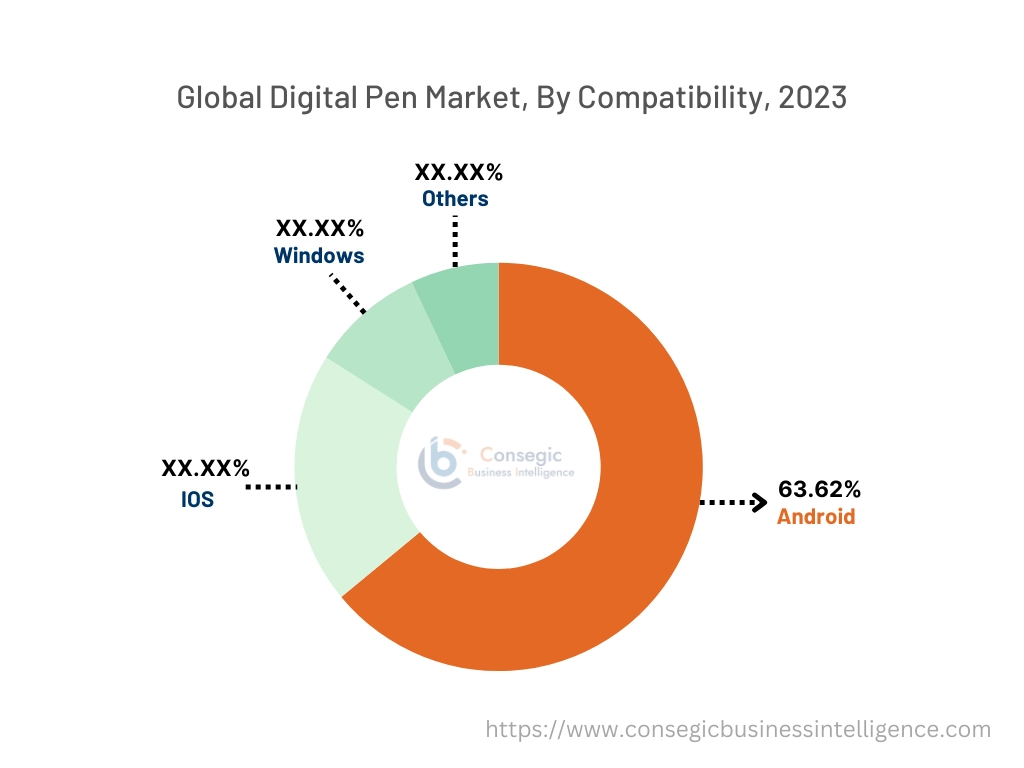
By End User:
Based on the end user, the market is segmented into BFSI, healthcare, government, media & entertainment, education, retail and others.
The healthcare segment accounted for the largest revenue share in the year 2023.
- The product with a blend of electronic circuits, optical devices, and Bluetooth, has been rapidly adopted by most hospitals and pharmacies due to its transformative impact on digitization. It simplifies the storage of comprehensive patient information, enhancing patient safety. Furthermore, numerous products have been adapted to be wireless, facilitating unrestricted movement. This widespread acceptance signifies a revolution in the process of digitization in healthcare.
- For instance, in July 2023, Doxper, a leading healthcare technology provider, offered a smart digital pen that revolutionized medical documentation. This innovative solution addressed the challenges of manual data entry into electronic health records (EHRs), a process that is often time-consuming, and error-prone for healthcare providers. The Doxper pen allows doctors to write as usual while its advanced algorithms capture and digitize the information in real time, enabling healthcare professionals to focus on patient care.
- Thus, the rising utilization of digital pens in the healthcare industry is driving the digital pen market demand.
The BFSI segment is anticipated to register the fastest CAGR during the forecast period.
- The BFSI sector aims at enhancing customer services, and most banks have quickly embraced integrated solutions involving tablets and digital pens.
- These advancements not only streamline the transition of data from analog to digital formats but also significantly reduce the labor and time involved in the process. This rapid adoption signifies a transformative shift in the banking industry.
- Therefore, the rising application of digital pens in the BFSI sector is anticipated to boost the digital pen market expansion during the forecast period.
Regional Analysis:
The regions covered are North America, Europe, Asia Pacific, the Middle East and Africa, and Latin America.
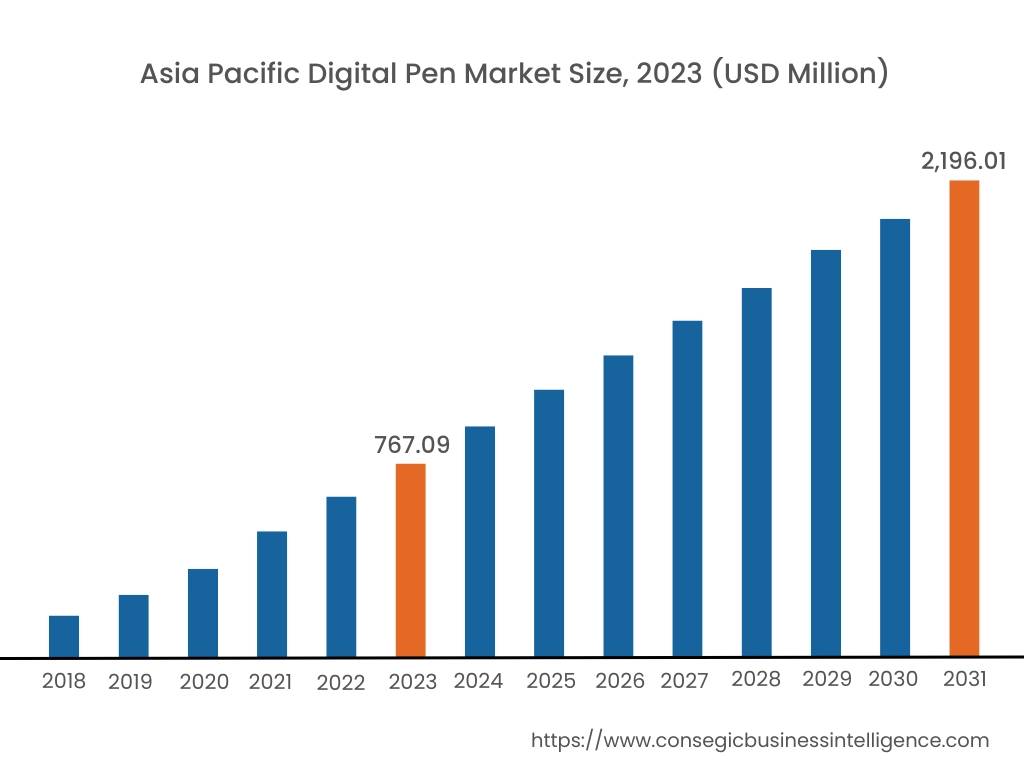
Asia-Pacific region was valued at USD 767.09 million in 2023. Out of this, China accounted for the maximum revenue share of 29.5%. Moreover, it is projected to grow by USD 860.37 million in 2024 and reach over USD 2,196.01 million by 2031. Asia-Pacific is the fastest-growing region in the digital pen market, driven by rapid digital adoption in education and corporate sectors in countries like China, Japan, and South Korea. Growing investments in smart classrooms and digital learning in China and India are major contributors. South Korea and Japan, with their tech-savvy populations, are seeing increasing demand for pens in the graphics, design, and animation industries.
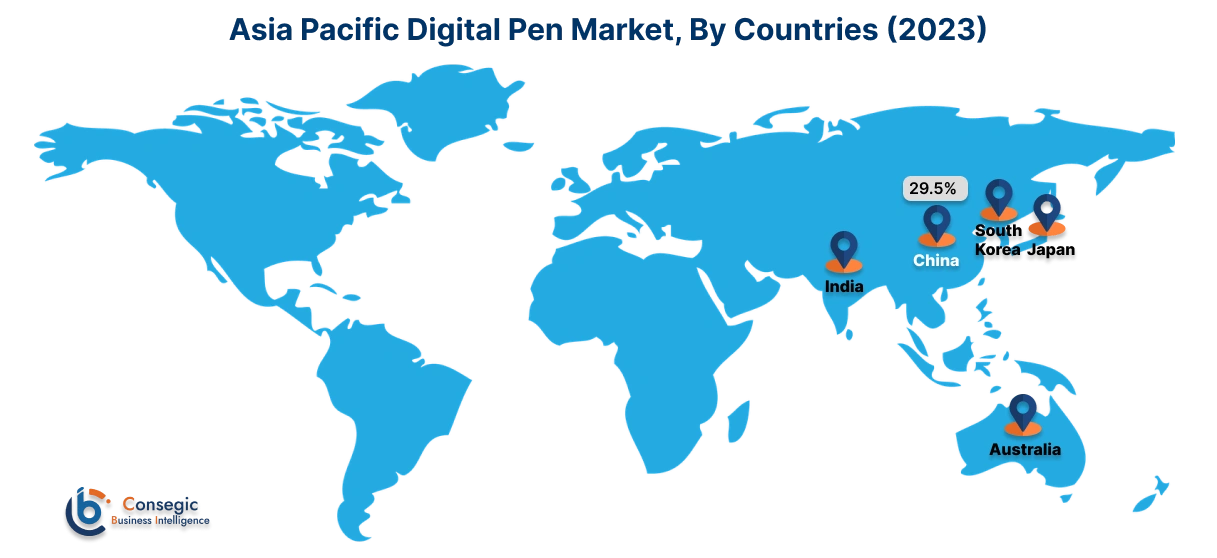
North America is estimated to reach over USD 2,503.76 million by 2031 from a value of USD 886.33 million in 2023 and is projected to grow by USD 992.99 million in 2024. As per the digital pen market analysis, North America holds a significant share of the market, driven by widespread adoption in education, healthcare, and corporate sectors. The U.S. leads due to strong investments in digital transformation and the use of pens in classrooms, hospitals, and workplaces for streamlined data entry and digital documentation. The demand is further supported by major tech companies developing advanced pen technologies. However, high costs and competition from alternative digital devices can challenge market expansion.
Europe is a key player in the market, with countries like Germany, the UK, and France leading adoption in education, banking, and government sectors. The rising demand for digital documentation, combined with the European Union's focus on digitalizing public services, supports market growth. Digital pens are increasingly used in the automotive and manufacturing sectors for technical design and annotation. However, regulatory concerns around data privacy and the cost of advanced pen solutions may limit digital pen market expansion.
The regional trends analysis shows that the Middle East & Africa region is experiencing steady growth, particularly in the UAE and Saudi Arabia. The region's emphasis on digital transformation, especially in the education and government sectors, is a key driver. Digital pens are increasingly used in smart government initiatives and digitized education platforms. However, high costs and limited access to advanced digital technologies in certain parts of Africa restrict the market's full potential.
Latin America is an emerging market, with Brazil and Mexico as leading contributors. The market is driven by increasing demand in education and corporate sectors for digital tools to improve productivity and data accuracy. Government initiatives to digitize classrooms and the adoption of digital tools in banking support market expansion. However, economic instability and limited technology infrastructure in some areas may impede growth.
Top Key Players & Market Share Insights:
The digital pen market is highly competitive with major players providing products to the national and international markets. Key players are adopting several strategies in research and development (R&D), product innovation, and end-user launches to hold a strong position in the global digital pen market. Key players in the digital pen industry include-
- Apple Inc. (United States)
- Microsoft Corporation (United States)
- IRIS S.A. (Belgium)
- Wacom Co., Ltd. (Japan)
- Lucidia (United States)
- Kent Displays, Inc. (United States)
- ACECAD Digital Corp. (Taiwan)
- NeoLAB Convergence Inc. (South Korea)
- Livescribe Inc. (United States)
- Moleskine S.p.A. (Italy)
Recent Industry Developments :
Partnerships, Mergers & Acquisitions:
- In May 2023, Apple and Google, two prominent digital pen manufacturers, have joined forces. This collaboration aims to eradicate unwanted device tracking, thereby enhancing the safety of the consumer experience in the tech world. The partnership signifies a proactive step towards addressing security concerns in the digital sphere.
Digital Pen Market Report Insights :
| Report Attributes | Report Details |
| Study Timeline | 2018-2031 |
| Market Size in 2031 | USD 7,074.76 Million |
| CAGR (2024-2031) | 13.7% |
| By Product Type |
|
| By Category |
|
| By Compatibility |
|
| By End User |
|
| By Region |
|
| Key Players |
|
| North America | U.S. Canada Mexico |
| Europe | U.K. Germany France Spain Italy Russia Benelux Rest of Europe |
| APAC | China South Korea Japan India Australia ASEAN Rest of Asia-Pacific |
| Middle East and Africa | GCC Turkey South Africa Rest of MEA |
| LATAM | Brazil Argentina Chile Rest of LATAM |
| Report Coverage |
|
Key Questions Answered in the Report
What will be the potential market valuation for the Digital Pen by 2031? +
In 2031, the market size of the Digital Pen market is expected to reach USD 7,074.76 million.
How big is the Digital Pen Market? +
In 2023, the Digital Pen market was USD 2,528.03 million.
What are the segments covered in the Digital Pen market report? +
Their product types, categories, compatibility, and end users are the segments covered in this report.
Who are the major players in the Digital Pen market? +
Apple Inc. (United States), Microsoft Corporation (United States), IRIS S.A. (Belgium), Wacom Co., Ltd. (Japan), Lucidia (United States), Kent Displays, Inc. (United States), ACECAD Digital Corp. (Taiwan), NeoLAB Convergence Inc. (South Korea), Livescribe Inc. (United States), Moleskine S.p.A. (Italy) are the major players in the Digital Pen market
